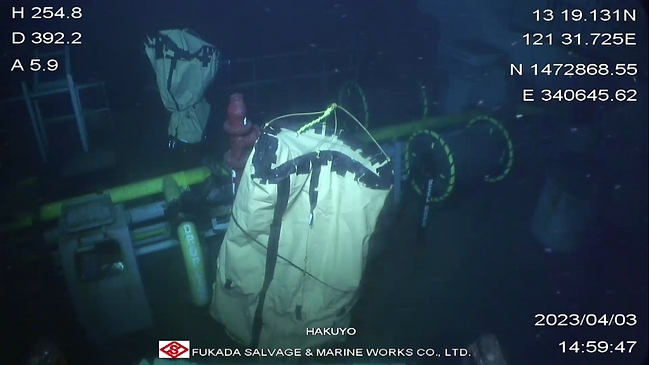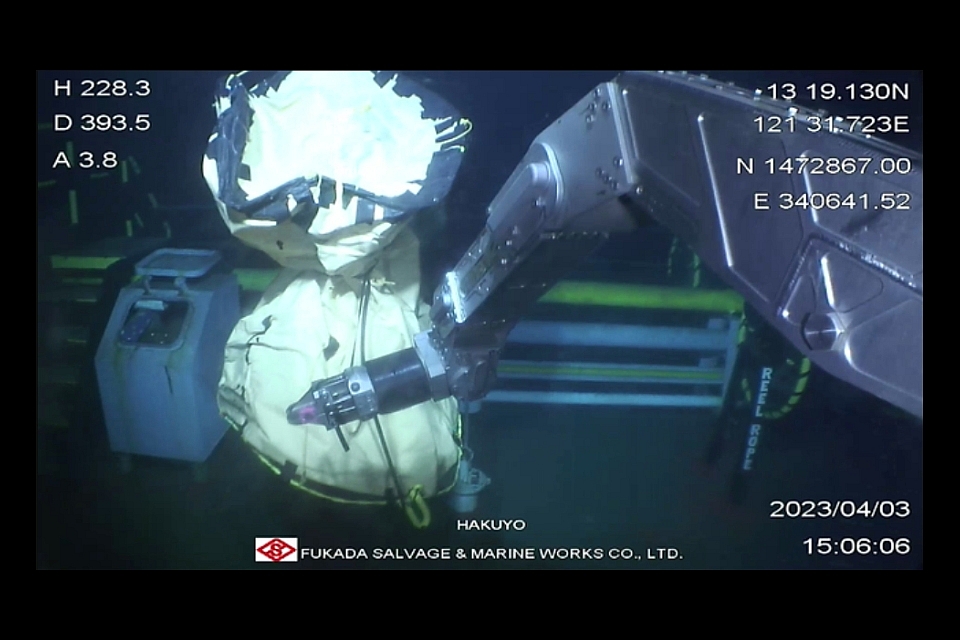RDC Reield Marine Services, owners of the sunken tanker Princess Empress, report that specialised oil leak capping bags have successfully been installed on areas of the wreck. A remotely-operated vehicle (ROV) operated by the Japanese salvage vessel Shin Nichi Maru installed the bags.
The tanker Princess Empress departed from Bataan en route to Iloilo with twenty crew members (including the master) and approximately 800,000 liters of industrial fuel oil on board at the end of February. It then encountered engine trouble due to overheating. The crew was evacuated and the tanker sank on 28 February. The ship is at a depth of 400 metres northeast of Pola, Oriental Mindoro and is leaking oil from all eight tanks and a massive oil spill response operation is underway.
The specialised bags from the United Kingdom and copied locally are designed to catch and contain oil escaping from areas on the vessel identified as leaking through previous ROV surveys.
Also read: Claims submission office for Princess Empress opened
ROV installation process
Each bag installation required a separate ROV dive with the initial placement of the bags over the targeted leak point and then a tying-off process with cable ties to ensure a seal. Underwater currents and obstructions around the hull made placing each bag a very challenging and technical operation. Despite the complexities involved, by the afternoon of Tuesday, April 4, the crew on the Shin Nichi Maru had successfully installed eight bags.

After each installation, further dive surveys were undertaken to identify other leak points for future reference. Some other identified leaks were inaccessible for bagging due to obstructions such as cargo nets, hoses, and ropes. The Shin Nichi Maru with ROV on board has been demobilised from the sunken vessel site. Salvage experts are now exploring viable options to remove any remaining oil from the wreck.
Also read: Tanker Princess Empress leaking oil from eight tanks
Oil spill response
On the surface, the at-sea response operations continue to collect oil that has leaked from the sunken vessel through the deployment of skimmers and manual scooping of oil contained by deployed booms.
Joint shoreline surveys between the various authorities, international experts and clean-up contractors have detected some areas of oiling to the north of already affected regions of Oriental Mindoro, with clean-up operations now underway at these sites.
Spill mitigation with high-volume flushing and high-pressure washing is ongoing in previously affected areas. Waste transferral of the collected oil and oiled debris to dedicated storage areas is underway to ensure safe storage before being shipped for disposal by government-approved contractors.
International representatives from the United States Coast Guard (USCG), National Oceanic and Atmospheric Administration (NOAA), Korean Coast Guard (KCG) and Oil Spill Response Limited (OSRL) have been monitoring the clean-up efforts.
Picture (top): ROV tying the capping bag off with cable ties (by MT Princess Empress Incident Information Centre).
Also read: Philippines launches oil spill response after tanker sinks








